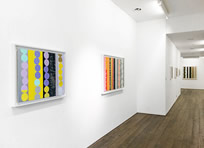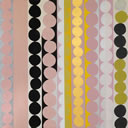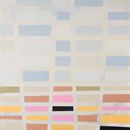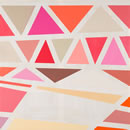Main Gallery
Chromatic Intuitions
26 February – 9 April 2016
Jennifer Durrant RA
From the series Ghirlanda
Kevin Laycock
Chaos and Roses
Art First is delighted to make this joint presentation of new paintings by two significant British abstract practitioners.
Jennifer Durrant first achieved recognition in the mid-1960s as a Young Contemporaries prizewinner (a few years on from Hockney, Blake and Riley) and paintings were acquired by the UK Arts Council and the Tate Collection over the following twenty years. There have been solo exhibitions at the Museum of Modern Art, Oxford, the Serpentine Gallery and Barbican, London, and at The Arnolfini, Bristol. She had influential teaching posts both at the RA Schools and at the Royal College of Art and was elected RA in 1994. Her shows at Art First since 2005 have extensively dealt with her instinctive and particular responses to her new studio and living environment in the Italian countryside near Perugia.
Sarah Kent wrote of the first Ghirlanda group in 2008:
...Consisting of irregular circles silhouetted against narrow bands of colour, Jennifer Durrant’s new paintings look simple – at first glance. But when I visited and tried to sketch them, I soon realised how deceptive this impression was. Collectively they are called ‘Ghirlanda’ (Garland), but they remind me of dangling strings of beads rather than flowers. Most of the circles hang in wobbly strands but, occasionally, an independent element floats free. Some are sliced in half and the two sides painted different colours; most are the same hue as their neighbours, but some are individually coloured.
Close inspection of the vertical bands reveals a similar degree of complexity. Some lie behind the circles, content to remain in the background; but others stand proud, turning the circles into voids or holes. Then come the colours; in one triptych I identified three different greens, three oranges, four variants on lilac, plus ochre, black and gold...
Not surprisingly, the results are highly individual and often strange. You won’t find these seductive pinks, ambiguous browns and skulking blues on a colour chart. Durrant’s concoctions are to standard paints what gourmet ice cream is to a Wall’s wafer. And if I had to give them names, I would probably borrow words like pistachio, limone, melone, fragola and tiramisu from Italian ice cream, displays of which seduce you at every turn in Umbria, with their rainbows of hyperactive colour.
She quoted Durrant:
It’s a question of fine-tuning them, so you have a sense of the colour going through the painting and giving it coherence. I want people to read them across as well as up and down; my concern is rhythm, and the painting being a solid object, built of layers of stuff, which underlines the whole and locks the shapes together. I want the paintings to have visual and emotional density so I move things around, to create something visually unexpected. ...To be moved or arrested by a painting, it has to be believable. And when its right – when it has an inner life and becomes an independent entity – a painting glows.
Kevin Laycock refers to Durrant as a primary influence in his artistic personality. He studied at the Royal College of Art during the mid-1990s and since then has conducted a studio-based practice whilst teaching as Lecturer in Art & Design History and Practice at the University of Leeds. There have been numerous public space exhibitions (at Oldham, Hull, Leeds, Darlington) as well as with Art First, London, and there are several publications incorporating all academic and artistic strands of his interests.
In common with other academically-orientated abstract painters he has a strong interest in some of the systems-based art movements of the past. This matches his long-standing musical training and has led to groups of paintings on paper and panel where specific codes and rules are followed – the most recent iteration being a collaboration with composer Michael Berkeley: Collision which included an animated sound piece and paintings governed by particular musical works. The creation of this series coincided with a recent bereavement leading to the emotional core of Chaos and Roses (referring to flower-filled rooms).
Laycock acknowledges influence by fellow design theorist, Professor Michael Hann whose most recent publication is, tellingly, Stripes, Grids and Checks (Bloomsbury, 2015). He has conducted considerable research into the structuralist paintings of the late British painter Jeremy Moon, whilst he also makes allusion to the lure of fashion-house culture.
The writer Jane Speller relates:
...all square, all oil on wood panel. The use of wood represents something of a departure for Laycock and is a result of his desire to create an extremely hard, clean, paint surface. This hard surface gives Laycock’s colour palette an extra vibrancy, the colours seem brighter and more arresting. Again, unusually for Laycock, he made a preparatory sketch for each work on graph paper as a way of plotting with absolute precision the arrangement of the geometric shapes within the confines of the square. Laycock describes the preparatory work as taking longer than the actual act of painting, completed with frenetic energy. He sanded down the surface after each layer of paint repeating this process many times.
The reaction of the viewer is paramount to Laycock and this group is designed to be immersive and seductive, creating a feeling of being balanced and settled. The sequencing of the work is important too, with each piece taking something from the last, building into a complete collection.









